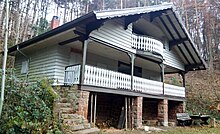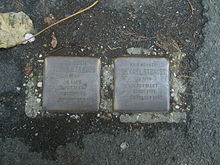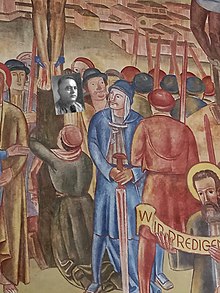Josef Bürckel
Josef Bürckel (born March 30, 1895 in Lingenfeld , † September 28, 1944 in Neustadt an der Weinstrasse ) was a National Socialist Gauleiter and bureaucrat in high political offices. Between 1935 and 1936 he was the “ Reich Commissioner for the Restructuring of the Saar Region ”, from 1938 “Reich Commissioner for the Reunification of Austria with the German Reich” and from 1940 to 1944 “ Reich Governor of the Westmark ” based in Saarbrücken and “ Head of Civil Administration ” (CdZ ) in Lorraine .
In 1939 Bürckel initiated mass deportations of Jews from Vienna , in October 1940 with the Baden Gauleiter Robert Wagner the deportation of the remaining Jews from the Gau Baden and the Gau Saarpfalz, known as the Wagner-Bürckel Action , and in November 1940 the expulsion of 60,000 Lorraine residents.
Family and education
Bürckel was born in the southern Palatinate as the youngest of four children of the baker Michael Bürckel and his wife Magdalena. He was catholic. In 1920 Bürckel married Hilda Spies from Landau, with whom he had two sons.
After elementary school in Lingenfeld, Bürckel attended secondary school in Karlsruhe , and from 1909 to 1914 the teacher training college in Speyer . At the First World War he took from 1914 to 1916 as a volunteer , first in the 12th , from 1 January 1915 at the 20th Bavarian Field Artillery Regiment in part. At the end of 1915, while on leave from the front, he passed the examination for the teaching post; as a candidate he was active in Lingenfeld, Ramberg , Bellheim and Minfeld . In 1919 he passed the practical teacher examination and then worked as a primary school teacher, until 1920 in Roxheim , then in Rodalben and from 1927 in Mußbach .
Political activity
Party member
Bürckel joined the NSDAP in 1921 as member 33,979 . From 1923 he took part in actions against the separatist movement in the Palatinate ; He is said to have been involved in the storming of the Pirmasens district office on February 12, 1924 in the background . In 1925 he rejoined the NSDAP, which had previously been temporarily banned. From 1940 until his death he was also the country leader of the " German People's Community in Lorraine " (DVG), the NSDAP offshoot in occupied Lorraine .
Party official
Westmark


From 1926 Bürckel was, as the successor to Friedrich Wambsganß , NSDAP Gauleiter of the Palatinate . On May 3, 1933 he was also Gauleiter or acting Gauleiter for the Saar area . This appointment was made two years before the Saar referendum on January 13, 1935, when the result was the “re-annexation” of the Saar area to the German Reich . However, Bürckel was only an official Gauleiter for a short time, because on March 31, 1933 , the responsible government commission declared the parties of the Saar area to be independent and thus formally separated them from the German Reich. Alois Spaniol was therefore used as Bürckel's straw man, but came into conflict with his unofficial superior. In 1935, Bürckel succeeded in using Jakob Pirro instead.
In 1935 the Gau Saarland was merged with the Gau Rhein-Pfalz to form the Gau Saarpfalz , which was expanded in 1942 to include the CdZ area of Lorraine to Gau Westmark . In 1935 and 1936, Bürckel was " Reich Commissioner for the Reorganization of the Saar Region". Thus he held an office that corresponded to the position of Reich governor. Bürckel held the office of Gauleiter until his death in 1944. From 1935 until his end he resided in the castle-like Villa Böhm in Neustadt, a work by the Jewish architect Ludwig Levy . In the district of Stauf in the north of the Palatinate , Bürckel had the Lassmichinruh hunting lodge built, where he often spent his free time with party friends.
Bürckel was considered a supporter of Gregor Strasser's rather socialist line and came into conflict with the Palatinate MP Ludwig Schickert .
Ostmark
On March 13, 1938, Bürckel was commissioned to reorganize the NSDAP, which had been banned in Austria since 1933, and to prepare the referendum after the annexation of Austria , which took place on April 10, 1938. After the vote, he became “Reich Commissioner for the Reunification of Austria with the Reich” that same year and thus an agent for bringing Austria into line. This initially referred to the commissar system: In Austria by this time there should have been around 25,000 so-called “wild commissioners” (especially in Vienna ), for whom, according to the Wiener Zeitung of June 3, 1938, “an orderly economic life would be permanent no more employment ”. Some of these commissioners have also confused "mine and yours" (according to this newspaper) . In July 1938, Bürckel finally brought the commissioner system under his control. Between 1939 and 1940 he was Gauleiter in Vienna, Reich Governor of the Ostmark and Reich Defense Commissioner ( Military District XVII) and thus responsible for the mass deportations of Vienna's Jews.
More functions
Since 1936 Bürckel was SA-Obergruppenführer and from 1937 SS-Gruppenführer . He was also SS-Obergruppenführer (SS-No. 289.830) in the NS Motor Corps from January 30, 1942 . After the armistice with France he was head of the civil administration of Lorraine, which he wanted to insert into a Gau Westmark . From March 11, 1941, his title was Reichsstatthalter in Westmark. From 1930 until his death in 1944, Bürckel was a member of the Reichstag .
Deportations

On August 20, 1938, Bürckel set up the Central Office for Jewish Emigration in Vienna and, as early as 1939, supported the head of the Central Office Adolf Eichmann in carrying out the first mass transports of Viennese Jews to Nisko near the Soviet border at the time. The first transports of the Nisko plan started at the end of October 1939 and were a “series test from a laboratory. […] With each attempt it is noted […] this is research work, scientifically studied final solution ”. In November 1939, Bürckel urged Himmler for further transports, but these were not approved by the Nazi Reich leadership. These first transports were described by Jonny Moser as the beginning of the Shoah . Of the more than 5000 deported Viennese Jews, only 500 returned to Vienna after 1945. Against the background of these first deportations, in Lorraine, Bürckel organized the deportation of the French families who had moved here after 1918 and the long-established “French friends” to central France. On 22 October 1940 he was with Robert Wagner in the Wagner-Bürckel action than 6,000 Jews from Baden and the Saarpfalz in concentration camps deport the unoccupied Vichy - France were such. B. in the Camp de Gurs . Many of the deportees perished in the first few weeks as a result of the stresses and strains of hunger, cold and wet. Most of the survivors were murdered in extermination camps from 1942 onwards .
Involved in the Sponeck assassination
On July 23, 1944, in the military prison of Fortress Germersheim , the imprisoned Lieutenant General Hans von Sponeck was shot by the SS on Himmler's orders , after Bürckel had pointed out the prisoner Sponeck shortly before. In 1941 Sponeck ordered his army corps to withdraw from the Crimea without consulting him and was sentenced to death for "negligent disobedience in the field". In 1942 Adolf Hitler commuted the sentence to six years imprisonment.
Death and grave
Bürckel died of natural causes on September 28, 1944. Richard Siebeck , then head of the Heidelberg University School, diagnosed around 11 p.m. on September 27, 1944: Toxic collapse, dysentery and poor general condition . The cause of death a few hours later was circulatory failure . Five days after Bürckel's death, Hitler awarded him the Teutonic Order , the highest distinction of the NSDAP.
His tomb in the main cemetery of Neustadt an der Weinstrasse achieved inglorious fame in 2017 . This was only created on August 23, 1947, when - by resolution of the Neustadt city council on August 5 of that year - the original grave, laid out during the Nazi era in the honor grove of the cemetery, was repealed and reburied in a "desolate old grave in the northeast corner of the cemetery ”.
The tombstone made of sandstone consists of five truncated pyramids, over which a stone bar marked with the personal data is placed. It was classified as a “historical monument ” worthy of preservation by the monument authority in Mainz, without it being able to be assigned any significance as a work of art . That is why the stone had to be put back there in 2016 after it was removed at the request of the descendants after the grave was dissolved. Subsequently, the measure was heavily criticized in public and the monument was referred to as a "mark of shame". On October 22, 2016, the 76th anniversary of the deportation of Jews, the name on the Bürckel memorial was covered with a white cloth and a red ribbon with the names of the 58 Jews deported from Neustadt was wrapped over it. The initiators of the association for the promotion of the memorial for Nazi victims in Neustadt wanted to "symbolically erase the name of the thousandfold murderer and give the victims their names back."
"I am ashamed that my hometown maintains a Bürckel memorial and is the only city in Germany that enables people to pay homage to a Nazi criminal."
Varia

In 1938/39 the artist and Nazi opponent Paul Thalheimer created a monumental altarpiece in the Ludwigskirche Bad Dürkheim showing a crucifixion scene. One of the criminals crucified next to Jesus clearly bears the facial features of Adolf Hitler. At the time, this apparently remained undiscovered, which is why today the picture is one of the region's very special art treasures. According to local lore, the painter immortalized other historical figures in the painting. It is not difficult to see Josef Bürckel to the right of the main cross, who is depicted with a red drunkard nose, probably because his high alcohol consumption was a topic of conversation everywhere.
The latter also gave rise to the corruption of "Gauleiter Bürckel" to the nickname "Bierleiter Gaukel" .
literature
- Peter Hüttenberger : The Gauleiter. Study on the change in the power structure in the NSDAP (= series of the quarterly books for contemporary history , No. 19, ISSN 0506-9408 ). Deutsche Verlags-Anstalt, Stuttgart 1969 (extended dissertation, Bonn 1966).
- Dieter Muskalla: Nazi policy on the Saar under Josef Bürckel. Harmonization, reorganization, administration . Saarbrücker Druckerei und Verlag, Saarbrücken 1995, ISBN 3-925036-94-6 .
- Peter Steinbach : The suffering - too heavy and too much. On the importance of the mass deportation of Southwest German Jews (PDF; 81 kB). In: Tribüne - magazine for the understanding of Judaism . Volume 49, issue 195, 3rd quarter 2010, pp. 109–120.
- Dieter Wolfanger: The National Socialist Policy in Lorraine 1940–1945 . 1977 (Diss. Phil. Saarbrücken University, 1976, not in trade).
- Dieter Wolfanger: Nazification de la Lorraine Mosellane 1940–1945 . Translated by François Serizay. Pierron, Sarreguemines 1982.
- Dieter Wolfanger: The fate of the Saarland Jews under Nazi rule (= contributions to regional history, 13th history workshop ). VFG-Verlag, St. Ingbert 1992, ISBN 3-928419-16-1 , online.
- Pia Nordblom, Walter Rummel, Barbara Schuttpelz (eds.): Josef Bürckel. National Socialist rule and allegiance in the Palatinate . Kaiserslautern 2019 (2nd expanded and improved edition, Kaiserslautern 2020).
Web links
- Josef Bürckel, career and photo ( memento from August 13, 2007 in the Internet Archive ), source: Bavarian State Center for Political Education
- Josef Bürckel in the Saarland biographies
- Josef Bürckel in the database of members of the Reichstag
- Reports on the situation in Saarland under Gauleiter Bürckel , source: sarrelibre.de - history & stories from the country in between
- Reports on the situation in Vienna under Gauleiter Bürckel , source: Documentation archive of the Austrian resistance
- Literature by and about Josef Bürckel in the catalog of the German National Library
- Newspaper article about Josef Bürckel in the 20th century press kit of the ZBW - Leibniz Information Center for Economics .
- Literature on Josef Bürckel in the Saarland Bibliography
Individual evidence
- ↑ a b c d e Ernst Klee : The personal dictionary on the Third Reich : Who was what before and after 1945? Fischer-Taschenbuch-Verlag, Frankfurt am Main 2007, p. 82.
- ↑ a b c d Wolf Gruner : The persecution and murder of the European Jews by National Socialist Germany 1933–1945 . Vol. 1: German Empire 1933–1937. Munich / Oldenbourg 2008, p. 558, ISBN 3-486-58480-4 .
- ↑ Hans Fenske: Josef Bürckel . In: Pfälzer Lebensbilder, Volume 6, Speyer 2001, p. 321 ff.
- ↑ Lothar Wettstein: Josef Bürckel: Gauleiter - Reichsstatthalter - Adolf Hitler's crisis manager . BoD, Norderstedt 2009, ISBN 978-3-8391-1761-3 , p. 28 ( online ).
- ↑ Lothar Wettstein: Josef Bürckel: Gauleiter - Reichsstatthalter - Adolf Hitler's crisis manager . 2009, p. 481 .
- ^ Gerhard Paul : The NSDAP of the Saar area 1920-1935 . Saarbrücker Druckerei und Verlag (SDV), Saarbrücken 1987, ISBN 3-925036-11-3 , p. 69-73 .
- ↑ Michael Wedekind: National Socialist Occupation and Annexation Policy in Northern Italy 1943 to 1945 . The operational zones “Alpine Foreland” and “Adriatic Coastal Land”. Oldenbourg, Munich 2003, p. 96 f., ISBN 3-486-56650-4 . (Source: Peter Hüttenberger: Die Gauleiter . Stuttgart 1969, p. 140 ff.)
- ↑ Gauleitung des Gaus 'Saarpfalz' on www.gedenkstätte-neustadt.de, accessed on July 13, 2015.
- ^ Lothar Wettstein: Josef Bürckel: Gauleiter Reichsstatthalter Crisis Manager Adolf Hitler , BoD - Books on Demand, 2010, pp. 376 and 572, ISBN 3-8391-9826-7 ; (Digital scan 1) , (Digital scan 2)
- ↑ Lothar Wettstein: Josef Bürckel: Gauleiter - Reichsstatthalter - Adolf Hitler's crisis manager . 2009, p. 371 ff .
- ^ A b Jörg Osterloh: National Socialist persecution of Jews in the Reichsgau Sudetenland 1938–1945 . Oldenbourg, Munich 2006, p. 314, ISBN 3-486-57980-0 .
- ^ SS Personnel Office: List of seniority of the NSDAP Schutzstaffel , as of December 1, 1937, serial number 57
- ↑ Hans Safrian : Eichmann and his assistants . Frankfurt / Main 1995, ISBN 3-596-12076-4 , p. 41.
- ↑ quoted from Murmelstein. In: profil , Vienna, December 14, 2009, p. 25.
- ↑ profil , Vienna, December 14, 2009, p. 21.
- ↑ Lothar Wettstein: Josef Bürckel: Gauleiter - Reichsstatthalter - Adolf Hitler's crisis manager . 2009, p. 540 .
- ↑ Lothar Wettstein: Josef Bürckel: Gauleiter - Reichsstatthalter - Adolf Hitler's crisis manager . 2009, p. 551 .
- ↑ Lothar Wettstein: Josef Bürckel: Gauleiter - Reichsstatthalter - Adolf Hitler's crisis manager . 2009, p. 22 .
- ↑ On the problem cf. Anke Petermann: The stumbling block. How appropriately to remember Nazi perpetrators? Contribution from March 24, 2017 to Deutschlandfunk Kultur .
- ↑ Annegret Ries: Bürckel debate rekindled . In: The Rheinpfalz , Mittelhaardter Rundschau . Ludwigshafen October 13, 2016.
- ↑ Bürckel grave monument . In: The Rheinpfalz , Mittelhaardter Rundschau . Ludwigshafen October 16, 2016.
- ↑ Ingrid Heyer: Everyone is responsible . Silent march on the anniversary of the deportation of Palatinate and Baden Jews to Gurs. In: The Rheinpfalz , Mittelhaardter Rundschau . Ludwigshafen October 24, 2016.
- ↑ Wedge on verlag-pfalzmundart.de
- ↑ Petra Depper-Koch: Churches of the Palatinate: Many superlatives , Die Rheinpfalz , December 22, 2017; (Digital view).
- ^ Franz-Josef Wittkampf: Hitler depicted in the crucifixion scene . In: Der Pilger , No. 1, of January 8, 2017.
- ↑ Spiegel article on Cardinal Innitzer, April 10, 1967.
| personal data | |
|---|---|
| SURNAME | Bürckel, Josef |
| ALTERNATIVE NAMES | Bürckel, Joseph |
| BRIEF DESCRIPTION | German politician (NSDAP), MdR, Gauleiter of the Gau Saarpfalz, Reich Governor of the Westmark |
| DATE OF BIRTH | March 30, 1895 |
| PLACE OF BIRTH | Lingenfeld (Palatinate) |
| DATE OF DEATH | September 28, 1944 |
| Place of death | Neustadt an der Weinstrasse |

